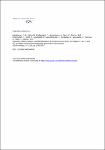Detection, differentiation, and identification of botulinum neurotoxin serotypes C, CD, D, and DC by highly specific immunoassays and mass spectrometry
Hansbauer, Eva-Maria
Skiba, Martin
Endermann, Tanja
Weisemann, Jasmin
Stern, Daniel
Dorner, Martin
Finkenwirth, Friedrich
Wolf, Jessica
Luginbühl, Werner
Messelhäußer, Ute
Bellanger, Laurent
Woudstra, Cédric
Rummel, Andreas
Fach, Patrick
Dorner, Brigitte
Botulinum neurotoxin (BoNT) serotypes C and D and their mosaic variants CD and DC cause severe cases of botulism in animal husbandry and wildlife. Epidemiological data on the exact serotype or toxin variant causing outbreaks are rarely available, mainly because of their high sequence identity and the lack of fast and specific screening tools to detect and differentiate the four similar toxins. To fill this gap, we developed four highly specific sandwich enzyme-linked immunosorbent assays (ELISAs) able to detect and differentiate botulinum neurotoxins type BoNT/C, D, CD, and DC based on four distinct combinations of specific monoclonal antibodies targeting both conserved and divergent subdomains of the four toxins. Here, highly sensitive detection with detection limits between 2 and 24 pg mL−1 was achieved. The ELISAs were extensively validated and results were compared with data obtained by quantitative real-time PCR using a panel of Clostridium botulinum strains, real sample materials from veterinary botulism outbreaks, and non-BoNT-producing Clostridia. Additionally, in order to verify the results obtained by ELISA screening, the new monoclonal antibodies were used for BoNT enrichment and subsequent detection (i) on a functional level by endopeptidase mass spectrometry (Endopep-MS) assays and (ii) on a protein sequence level by LC-MS/MS spectrometry. Based on all technical information gathered in the validation study, the four differentiating ELISAs turned out to be highly reliable screening tools for the rapid analysis of veterinary botulism cases and should aid future field investigations of botulism outbreaks and the acquisition of epidemiological data.
Dateien zu dieser Publikation
Keine Lizenzangabe

